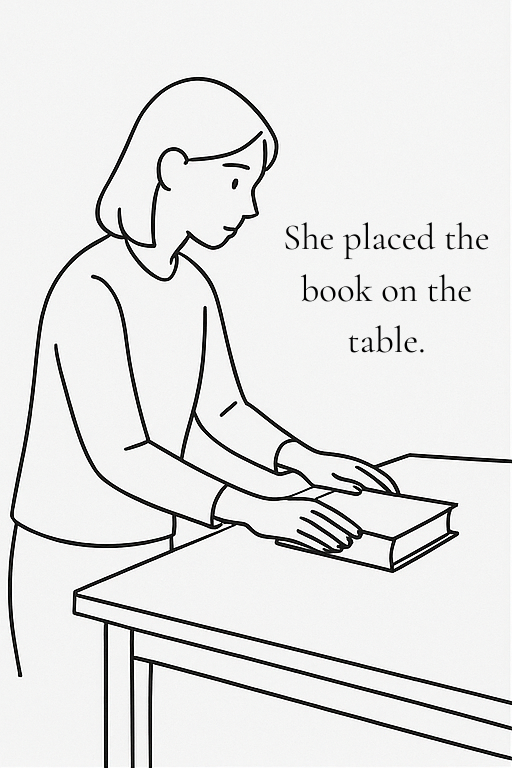☽⋆☾
☽⋆☾

The Painter’s Lexicon
Describing Without Over-Describing
☽⋆☾
There’s a moment in every writer’s journey when description becomes too much of a good thing.
You set out to paint a scene — lush, vivid, cinematic — and somehow end up with three paragraphs describing the curtains. The impulse is noble: you want the reader to see what you see. You want atmosphere. You want tone. You want to show.
But description isn’t about piling details into a scene.
Description is selection.
The painter doesn’t use every colour on the palette.
The painter chooses.
Good writing works the same way.
Showing Vs. Over-painting
☽⋆☾
‘Show, don’t tell’ is often misunderstood as ‘describe everything in detail.’ That’s how we end up with sentences like:
She walked into a room with burgundy velvet curtains trimmed with gold tassels, a chandelier shaped like a flowering vine, three armchairs upholstered in damask-lilac brocade…
You can feel the intention: Look at all these details — see how vivid I’m being! — but the effect is the opposite. Too many details becomes noise. They don’t immerse the reader; they overwhelm and even bore them.
Instead of entering the room through the character’s experience, the reader ends up watching the writer carefully adjust the décor. It becomes a performance of description, not an experience of story.
Showing is not about quantity. It’s about choice.
The question is not: ‘How do I describe this room?’ It’s: ‘What detail tells the story of this room?’
Heavy curtains that muffle sound → secrecy, privacy, conspiracies.
A chandelier dulled with dust → neglect, abandonment, the echo of former elegance.
An armchair cushion still warm → someone was here. Recently. Where did they go?
These details pull their weight. They hint. They shape the atmosphere. They move the story. Everything else is wallpaper.
Description is not neutral, however. Point of view matters. A room doesn’t look the same to every person who enters it.
An artist notices textures of light.
A thief notices exits and blind spots.
A grieving son notices the empty chair where someone used to sit.
When you describe a scene, you’re not just showing what is there. You’re showing what matters to the person seeing it.
So the core question becomes: Who is looking? And what does this person notice first?
A tired traveller may notice the softness of the chair.
A suspicious detective may notice the dust on the chandelier.
A jealous lover may notice the second wine glass on the table.
Same room. Entirely different descriptions. Entirely different truths.
Description is character. When you choose which details to reveal, you reveal the perceiver as much as the world itself.
This is why description is powerful — not because it paints a scene, but because it paints a perspective.
Choose Specific Rather than Many
☽⋆☾
When a writer worries the reader might not quite see what they mean, the instinct is to add more adjectives. A little shimmer here, a soft, delicate, gentle hue there. Just one more descriptive word. And another. And another.
Adjectives start to multiply like rabbits in moonlight.
She wore a light, shimmering, delicate, pale blue dress that looked soft and elegant.
Nothing in that sentence is wrong, but everything is vague. Words like light, delicate, soft, and elegant are feelings, not images — they gesture at an idea of beauty rather than choosing a specific image that the reader can see.
More words rarely create clarity. Specific words do.
Try this instead:
She wore a dress the colour of the early morning sky.
or,
Her dress was silk, quiet but expensive.
In each case, fewer words accomplish more work. They don’t describe every aspect of the dress — they suggest its character. Suggestion invites the reader’s imagination to collaborate, and collaboration is the magic of fiction.
Specificity is precision, not clutter.
Rather than piling descriptors on top of a thing, try making one careful choice:
Instead of bird, say rook.
Instead of flower smell, say crushed lavender.
Instead of tree, say an old beech with silver bark.
This doesn’t mean always choose the rarest or fanciest word. Over-specific description can feel performative in its own way.
It means: Choose the word that reveals something. About the world, the moment, or the character noticing it.
Consider what changes when we choose sharper nouns:
She placed the book on the table.
She placed the ledger on the bureau.
She placed the journal on the desk.
She placed the spellbook on the altar.
Same action. Different story.
A single word can shift the entire scene’s meaning, context, tone, and emotional resonance.
If you feel tempted to add more adjectives, ask:
What am I trying to communicate?
Is there a single concrete word that communicates this better?
What one detail gets me closest to the heart of the thing?
Description should distil, not dilute. When you choose specifics, you’re not just painting the scene more vividly. You’re communicating intention. You’re telling the reader: This is what matters here.
And that — quietly, elegantly — builds trust.
Sensory Writing as Perspective
☽⋆☾
The Sensory Checklist
Writers are often taught to “use all five senses.” And, with the best of intentions, many take that to mean:
Describe everything the character can see, hear, smell, feel, and taste.
Which leads to passages that feel like someone cataloguing a scene rather than experiencing it:
She smelled bread. She heard birds. She felt the wind. She saw children playing.
This isn’t sensory writing. It’s a police report.
True sensory writing reveals inner life. Sensory details matter only when they’re filtered through the character’s state of mind.
A grieving character passes a bakery:
Warm bread, and for a moment her chest hurt — home, before the hospital rooms, before silence became a language.
A hungry character passes the same bakery:
Butter and heat hung in the air. Her jaw ached with wanting.
Same place. Same smell. Different story.
Sensory details are emotion in disguise, the very essence of show don’t tell.
A character is afraid:
The kitchen was hazed with smoke, heat pressing close, the kind that makes walls feel too near.
A character is angry:
The pan spat oil like an insult.
The senses are a lens. Every detail we choose to describe reveals the person who noticed it. Fear sharpens the shadows. Love softens the edges. Grief echoes in the ordinary.
So, choose carefully. Not more. Not louder. Only true.
The right detail is enough to let the reader step inside the soul.
Your Character Has Dominant Senses
People don’t observe the world in the same proportions. We each have preferred sensory channels — one or two senses through which we naturally interpret reality.
Some characters:
See first: colours, shapes, spatial relationships.
Hear first: tone, rhythm, silence, subtext.
Feel first: weight, texture, warmth, pressure.
Smell/taste first: memory-triggered emotion, instinct, intuition.
A visual thinker will describe:
dust motes turning in sunlit air.
A tactile thinker will notice:
the worn-smooth edge of the chair where hands have held on.
An auditory thinker might catch:
the way her name is spoken. Too soft. Too careful.
This isn’t just about description. It’s psychology. It reveals how your character understands the world.
Choosing which sense your character relies on most gives them:
Personality
Consistency
Emotional signature
It turns a description into a voice.
A Simple Question to Ask Yourself:
What is the first thing this character notices in this moment — and what does that reveal about them?
If you answer that honestly, your description will take care of itself. You’re no longer describing a room.
You’re revealing a life.
If your story has a world waiting to be revealed, and you’d like a guide to help you uncover the details that shine the brightest — I’m here.
You’ll find my editing and worldbuilding offerings inside The Writer’s Spellbook. Just click the seal to open it and explore the enchantments inside.





